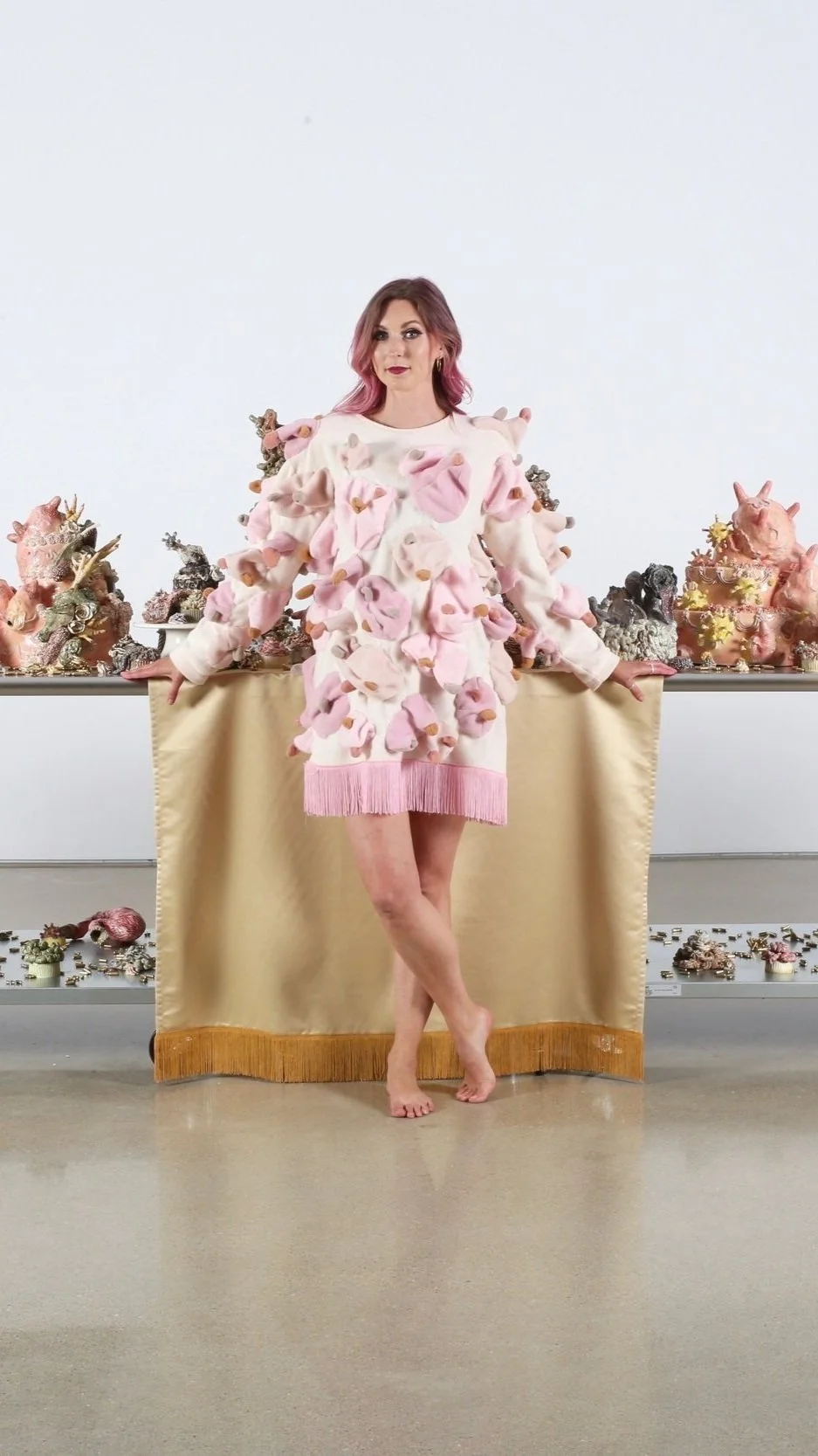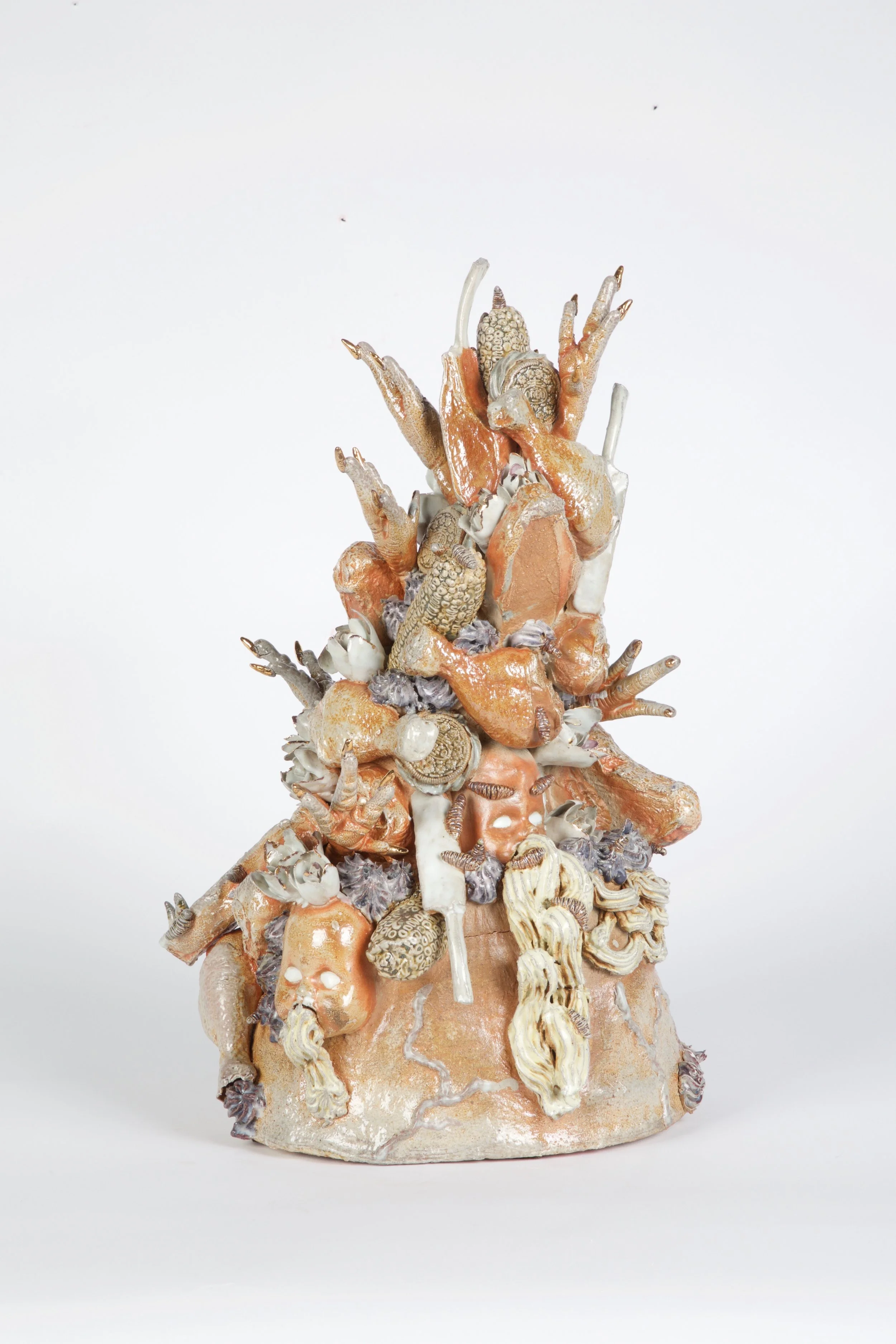Julianna ZR
Julianna ZR: Using the medium of ceramics, my practice currently explores the reality of food production, gluttony, and ignorant consumption within the Western World, through a grotesque and playful lens. In my series Table Manners, I use the abject to create unpleasant, uncomfortable, and surreal pieces about food consumption, causing a breakdown of borders between self and other. Abjection allows me to challenge cultural concepts and familiar narratives by provoking disgust, fear, or repulsion. The use of abjection and horror provides the space for posing challenging questions, often with problematic and overwhelming answers, sometimes too difficult to digest. Food often brings us together for celebration, it’s needed for survival and it offers us comfort, memories, and joy. My work explores a side of consumption and excess most of us would prefer to ignore, hideaway, and pretend doesn›t exist. The use of the uncanny and abject simultaneously draw the viewer in and push them away, rejecting what is in front of them. My work creates a space to display grotesque amounts of excess, an over-abundance of items we consume for sustenance and pleasure while turning a blind eye to the darker side of food production and the threat it poses to humanity’s long-term survival. Julianna is an emerging artist, born in Winnipeg and raised on the prairies of Southern Manitoba. She completed her first BFA at the University of Manitoba in Art History with honors. In 2017, she received her second BFA from Emily Carr University of Art and Design in Visual Art. While attending Emily Carr, she had the opportunity to take part in an exchange program and study in Tallinn, Estonia at the Estonian Academy of Arts (EKA). She recently defended her MFA thesis at the University of Manitoba with her work Table Manners. Her works primarily focus in clay, but she also extends her practice to textiles and sculpture. Julianna currently resides in Winnipeg, Canada as a practicing artist.
Julianna ZR Interview
1. Hi Juliana, can you tell us about your background. How and when did you first start to making ceramics?
My background is in Art History and in Visual arts. I completed my first BFA in 2011 at the University of Manitoba in Art History. It wasn’t until a few years later when I moved to Vancouver and attended Emily Carr University of Art and Design that I discovered ceramics. I began a visual arts degree thinking I wanted to become a teacher, but I took one ceramics course in my second semester and after the first class, I was hooked. That was in September of 2015 and I’ve been doing ceramics ever since. For me, ceramics offers endless possibilities which I find challenging, surprising, and engaging.
2. What is your main source of inspiration?
I’m inspired by many things, it’s hard to name one. My most recent work Table Manners has been inspired by food, but it goes much deeper than that. I have been inspired by where I was raised on a farm in Southern Manitoba, the agricultural environment I grew up surrounded by, my love and understanding of where the food we eat comes from, my passion for cooking, baking, and sharing food with others. When we share food with others, we are sharing a part of ourselves, I’m interested in how food can bridge gaps between controversial and complex topics. In my work, Table Manners I am discussing a contentious subject matter surrounding food and the many complexities surrounding it. As I keep researching and learning more about our food system and how everything is interconnected, I keep finding more and new inspiration to make ceramic work about. 3.
What is your process like? How do you begin to work?
My ceramic sculptures and process begin in a few different ways. For some sculptures, I have a clear vision of what I want to build and make. This usually comes after I’ve researched my subject matter, sometimes a sentence in a book that stands out or I’ve had a valuable critique leaving me with many great ideas. Most of the time though my work always evolves from the last thing I made. While I was at Emily Carr, I began making cow udder cakes, I was questioning what we consider “natural”, what is meant for human consumption, along with excess and unconscious consumption within our dairy industry. My cow udder cakes lead me to apply to grad school where I was able to explore these ideas further. The cow udder cakes have continued to make an appearance throughout my work, but they have evolved into something more complex and sinister. The cow udder cakes have informed other work and were he jumping off point for my graduate work.
4. As you mentioned, the use of the uncanny and abject simultaneously draw the viewer in and push them away in your work. Therefore, your approach to art is where the grotesque and beautiful meet, how do you describe this theme to your subject matter?
I use the abject and uncanny throughout most of my sculptures, it allows me to seduce the viewer and keep them engaged in each piece. The use of abjection confronts and disassociates us from the horrors of food production practices, excess, and our ignorant consumption. The abject allows me to create works with unpleasant, grotesque, and surreal elements, causing a breakdown between self and others. The grotesque merges horror and humor, provoking more questions and curiosity about what is on display. Using the grotesque throughout my work can push boundaries or eliminate borders between “normal” and “abnormal,” while destabilizing social norms, it can also create a space of conflicting possibilities. I find there is power and an irresistibility in horror that we have trouble looking away from. The grotesque allows us to consider further what we are looking at, rather than dismiss or avoid engagement. Yet the beauty, intricate detail, and use of many pastel colors draw the viewer in for further inspection. Many of my works reference cakes and desserts, yet they are not what they appear to be. The cake-like sculptures act as a vehicle to discuss more serious matters. As we typically see them as beautiful and irresistible they become the perfect form for more controversial issues. Cakes and desserts may be some of the most powerful, enjoyable, and desirable foods within many cultures. They are familiar to many of us and often found at a celebration, or events, but they can also hold underlying themes of guilt, gluttony, and lack of self-control. My ceramic sculptures evoke a visceral reaction while capturing a moment between luxury and decay, beauty and the grotesque. My display of ceramic cakes and extravagance creates a snapshot of an even more disturbing setting, leaving the viewer possibly feeling ill or over consumed and questioning their consumption habits. Many of the sculptures I have created are beautiful and repulsive, enticing and disturbing. These two opposing ideas keep drawing the viewer in for further inspection and to find more than what appears.
5. Can you explain more how do you work on the dark side of the consumption and the food industry by provoking disgust, fear, or repulsion in your ceramics?
My work is confrontational while using a dark sense of humor with an uneasy familiarity. I create many food items we recognize such a chicken or steak, but when mixed with icing, maggots, and flowers, it creates an uneasy reaction. This dark humor engages and disarms the viewer and is able to communicate ideas without being didactic. I am interested in creating works for the viewer to take a moment and pause about their own consumption habits or just to question a bit more about what is it they are eating. By using the abject and the medium of ceramics in my art practice, it allows the viewer to question taboo subject matter surrounding food and consumption in a more approachable way. My work explores a side of consumption and excess most of us would prefer to ignore, hideaway, and pretend doesn't exist. I am creating a safe space to open up a dialogue without causing the viewer to feel attacked, inviting them to view this matter from a different perspective. Ceramics is a medium many of us are familiar with on a domestic level and find nonthreatening. Within my work, I use humor and grotesque imagery to act as a mirror, to reflect back to us some of the absurd contradictions and horrors of our food system. Creating bizarre, alluring, and grotesque ceramic works invites curiosity and interest. My work raises the importance of understanding and being critical of what we are eating, the consequences of our food choices, and the many relationships within our food system. My works hauntingly remind the viewer of the dark side of our food sources, the processes employed in current food production, and our own complacency.













